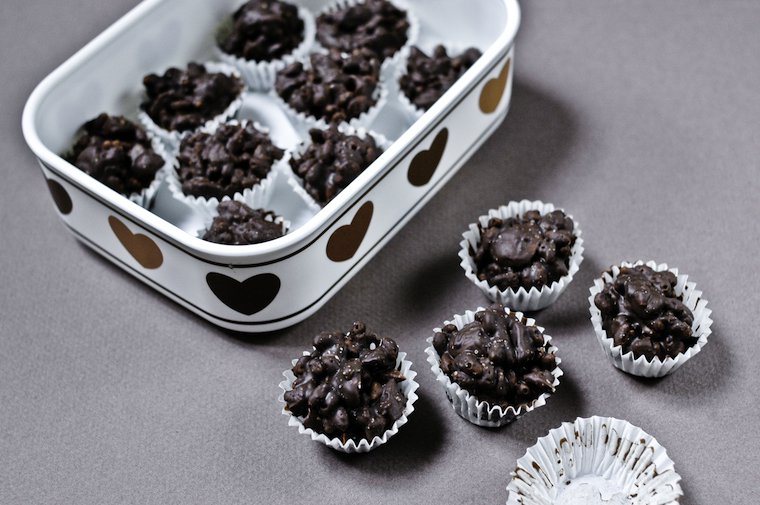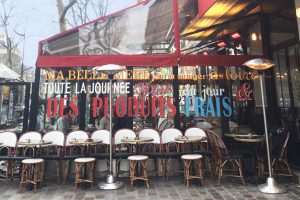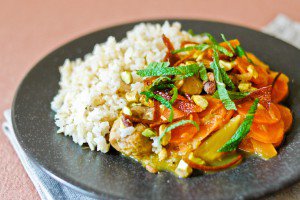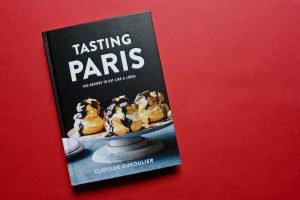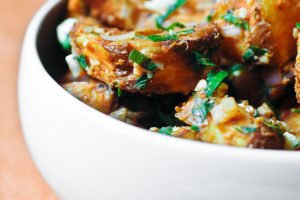Bouchées croustillantes au chocolat, amandes et gingembre
These chocolate clusters are the result of my recent and irrepressible urge to declutter. I would chalk it up to the advent of spring if it hadn’t been so stubbornly cold, and if I didn’t find myself in that state of I-can’t-bear-to-live-with-this-stuff-for-a-minute-longer several times a year.
Actually, one of my resolutions for the new year is to take on at least one decluttering project every weekend. It can be something quick, like sorting through the restaurant business cards we’ve accumulated over the years and removing the ones we’ll likely never visit again (done), or something ambitious, like reorganizing our overstuffed basement, recycling/tossing/giving old things away (check).
My rule of thumb is to use 1 cup of dried fruits and nuts plus 1 cup of puffed grain for each 250 grams (9 ounces) of chocolate; this creates an ideal crisp/crunchy/chewy texture.
It’s not that we buy that much stuff to begin with, but clutter seems to build up out of nowhere; perhaps a good theoretical physicist will one day study the phenomenon. In any case, I find it relaxing to know I have a counter-strategy in place, and it’s easy to tailor the size of the endeavor to the time and energy I have, yet still get a nice feeling of accomplishment. I even write down what I’ve done each weekend, to keep track; I don’t go so far as to award myself little congratulatory stickers, but I’m this close*.
The approach applies to the kitchen, too, and I try to go through my cabinets and drawers with as unsentimental an eye as I can summon, and prune, prune, prune. What I no longer need I sell or give away. There is a special shelf in the lobby of my apartment building, and the unspoken rule is that one can leave objects, books, and magazines there for others to take. They’re unfailingly snatched up in a matter of hours, and it’s fun to think that some of my unneeded utensils simply live on another floor now.
And of course, my pantry also needs to undergo that treatment on a regular basis, to refresh my memory as to what it contains (the cabinet is so ill-conceived I have to take everything out to get a good look), group ingredients together with a semblance of logic, and identify those that need to be used up soon.
Chocolate clusters to the rescue!
Unfailingly, I turn up small leftover amounts of dried fruit and nuts I want to use before they have a chance to shrivel up entirely or go rancid**, and these chocolate clusters are a delicious way to do so: they’re simply made by combining your choice of nuts, dried fruit and puffed grain with melted chocolate, and letting the clusters set.
(And by a happy coincidence, they’re also a perfect use for the box of 1,000 mini paper cups I’ve been working my way through for the past, um, six years.)

The chocolate cluster is a classic confection, but I only started making them after buying some at a chocolate shop in Barcelona a few years ago. Their version was called Trencadent and I couldn’t stop eating them; I tried making them after coming home to Paris, and it turned out to be the easiest thing ever.
A flexible formula for chocolate clusters
My rule of thumb is to use 1 cup of dried fruits and nuts plus 1 cup of puffed grain for each 250 grams (9 ounces) of chocolate; this creates an ideal crisp/crunchy/chewy texture and chocolate-to-filling ratio.
Make up your own combos depending on what you have on hand!
The puffed grain is there mostly for texture; the flavor is brought on by the nuts and the dried fruits. The following pairings I’ve tried and liked:
– almonds + candied ginger (as below),
– pistachios + dried apricots,
– peanuts + dried cherries,
– Brazil nuts + dried figs,
– almonds + candied orange rind,
– hazelnuts + raisins.
But really, you can make up your own combos depending on what you have on hand, or visit Sara or Dorie for more suggestions.
You could certainly add some spice or a touch of ground chili, but neither is necessary. Just remember to toast the nuts, so their flavor will be at its maximum.
And let me remind you that Easter comes early this year — Easter Sunday is on April 4 — so if you’re in the market for an easy giftable chocolate idea, this may be it!
~~~
* Need help decluttering? Take a look at the Apartment Therapy Home Cures, which offer helpful weekly assignments, advice, and support. The spring home cure has just started, and the kitchen cure is under way.
** My freezer is too small and too humid to keep nuts safely, but if you have room in yours, it is said to be a good way to ward off rancidity.

Have you tried this? Share your pics on Instagram!
Please tag your pictures with #cnzrecipes. I'll share my favorites!
Ingredients
- 250 grams (9 ounces) good-quality dark chocolate, preferably couverture-grade (see note)
- 80 grams (a slightly rounded 1/2 cup) whole unblanched almonds, toasted
- 80 grams (a scant 1/2 cup) candied ginger (a.k.a. crystallized ginger)
- 60 grams (1 cup) puffed rice (or other puffed grain)
- 1/8 teaspoon sea salt, plus a little more for sprinkling
Instructions
- Have ready about 35 mini paper cups (2.5 cm or 1 inch across the base is a good size), or a silicone baking mat, or a sheet of parchment paper.
- Chop the chocolate finely and melt it in a double-boiler (i.e. place the chocolate in a heatproof mixing bowl over a pan of simmering water, not allowing the bowl to touch the water), stirring regularly to ensure even melting. If you have a candy thermometer, the chocolate temperature to shoot for is 31-32°C (88-90°F) (see note); if you don't have one, don't worry about it.
- While the chocolate is melting, chop the almonds and ginger roughly.
- When the chocolate is melted, remove the bowl from the heat and place it on the counter. Add the almonds, ginger, puffed rice, and salt, and stir gently with a spatula to combine thoroughly.
- Using two teaspoons, scoop the mixture into the prepared paper cups, or just plop little mounds onto the silicone mat or parchment paper. (Alternatively, you can spread the mixture in an even layer and then break it into shards once set.) If you like a little salty jolt, sprinkle a touch more salt on top; be light-handed, though.
- Let rest somewhere cool (but not in the fridge) until completely set.
Notes
- Couverture chocolate is higher in cocoa butter than ordinary chocolate. It is therefore more fluid when melted, which makes it easier to work with and ensures a thinner, more even coating.
- This will allow the chocolate to take on a smooth, shiny finish.


